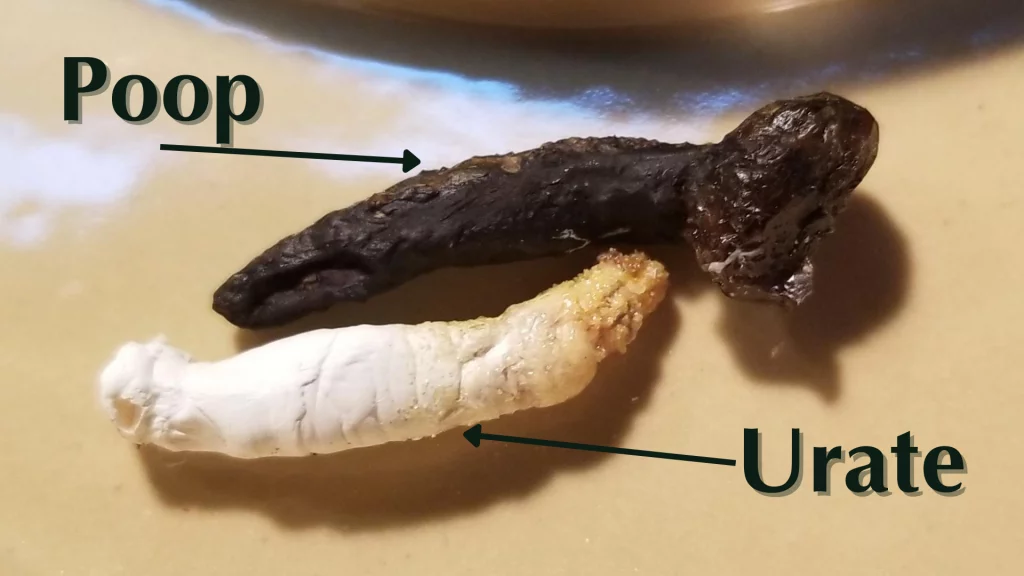Bowel movement is an essential factor in one’s body health. And the same goes with the bearded dragon poop. The texture, appearance, frequency, and types of bearded dragon poop help you to understand your beardie’s health condition. Thus, I have discussed every relevant thing that can help you to fix the prevalent issues with their poop. So, keep scrolling down.
How Often Do Bearded Dragon Poops?
Regular bowel movement frequency is a significant indicator of good health. Do your pet poop daily or doesn’t poop at all? Whatever the problem is, I have discussed the matter in detail. Don’t miss it.
Adult healthy bearded dragon poop more frequently compared to young bearded dragon. For instance, adult bearded dragon can poop 1 to 7 times weekly.
On the other hand, younger bearded dragons poop 1-3 times a week. And the baby bearded dragon poop every other day.
If your pet poops more than one or two times per day, there is a possibility that it is going through digestion problems. Make sure to take immediate action. So, you must monitor your pet’s poop schedule carefully.
But, if your beardie is not pooping regularly, check out the following segments to see what could be the cause behind this.
Why is My Bearded Dragon Not Pooping?
As I said before a bearded dragon should be pooping on a regular frequency. But if it doesn’t poop at least once per week, it must be having some health issues like low metabolic rate, distress, and pregnancy.
A female bearded dragon will poop more frequently than a healthy one. Not having a proper diet, and parasites also can make your pet poop less.
Apart from this, environmental changes also can affect its pooping schedule. Notice if the lighting level or temperature level in the house has been fluctuating lately.
The Solution to Constipation
If your pet dragon hasn’t pooped for a week, you can do the followings for your bearded dragon to poop on their own. First, try giving it a warm bath for around 10 to 15 minutes.
In the meantime, give a massage on its stomach gently. Give them a proper diet and calcium-based food. It will make them poop easier. Another way is to make them lick some olive oil as it can work as a laxative substance.
If all that home remedy doesn’t work, go to a professional veteran and seek guidance. Taking proper initiative at the right time is necessary to keep your beardie healthy and fit.
What a Healthy Bearded Dragon Poop Should Look Like?

Are you wondering what a healthy dragon poop should look like? Mainly, the appearance of a reptile’s poop is determined by the color, texture, and shape of the droppings.
It is also important to take note that, all these things depend on the age, diet, and overall health of your reptile. However, if your pet is pooping properly or not, can easily be identified on the basis of the following terms.
Bearded Dragon Poop Colors and Their Explanation
1. Brown poop
Typically poop or the color of the excrement of a healthful beardie appears brown. It will have white or yellow urates at the same time which might appear as a chalky substance.
The urate isn’t overly liquid or has a strong odor. In summary, when your pet’s poop is brown, its health is in optimal condition.
2. Green Poop and Black poop
When the poop is green, it indicates your beardies have mostly vegetables in their diet, while black poop indicates that your bearded dragon has recently eaten too many insects. What you have to do is to adjust their diet accordingly.
It’s noteworthy that if your beardies’ poop is black despite having adequate vegetables, check for other symptoms also. If you see other abnormalities, it’s better to make it see a reptile physician.
3. Bloody or red poop
But if your bearded dragon pooping bloody or red, it refers to unhealthiness. Because red poop is caused by parasites or impaction usually. On that note, it’s better not to delay but to consult with a reptile veterinarian.
4. Yellow poop
Yellow poop indicates excessive calcium intake. So, if your pet beardie is pooping yellow, decreasing the amount of its calcium-based food would be enough.
Make sure, that the limit shouldn’t be below the standard amount. Otherwise, it will affect your pet’s health.
5. White poop
The chalky white stool is an indication of dehydration of your dragon pet. Re-hydrate it with proper moisture food and drink without delay. Keep monitoring its pooping color until it turns normal. I’m sure you will not want your pet to go through such pain.
Consistency or Texture of the Pooping

Generally, a pet dragon’s poop has a firm and formed consistency. It means not too much watery nor too hard or dry.
If your dragon has runny poops, it indicates digestive issues. Perhaps, you are feeding it watery or high in moisture content.
On that note, feed it appropriate amounts of vegetables, fruits, and insects. If the condition doesn’t improve, it’s best to get a consultation from a vet for further evaluation.
On the other hand, if the poop is extremely dry or hard, it could be a sign of dehydration. Like the human body, reptiles also need to have a proper amount of water intake.
Inadequate hydration can be a serious concern for your beardie sometimes. So make sure to provide them with clean water and check if they are drinking it in adequate amounts.
In addition to that, you can add more moisture-rich foods to their diet.
5 Common Signs of Digestive Issues in Bearded Dragon Poop
I will share with you 5 top signs to look for in your reptile’s poop — to be sure whether it does have digestive issues or not. Diagnosing the disease is the first and foremost step to cure it. So, let’s check them out.
- Diarrhea
- Runny or excessive urate
- Change in color
- Undigested food particles
- Unusual odor
1. Diarrhea
Diarrhea is very common in almost every animal which has digestive issues. Variety factors including improper diet, bacterial infections, parasites, or underlying health issues can cause diarrhea. So, often a bearded dragon may have diarrhea while suffering from digestive issues. Hence, take measures right away to treat your bearded dragon diarrhea.
2. Runny or excessive urate
A normal bearded dragon will poop brown contents with some urate component of a white chalky texture. Their poop may appear excessively runny, slimy, or discolored when a bearded dragon gets digestion problems. It could be a sign of kidney or liver problems.
3. Changes in color
Slight variations in color are not abnormal. But if you see significant changes in the color of poop, it might be because your reptile is having digestive issues. For example, black stool refers to bleeding in the gastrointestinal tract, orange poop refers to ingestion of particular foods or a sign of internal bleeding.
4. Undigested food particles
Noticing undigested food particles in the poop of your pet beardie? Well, when the things consumed by your beardie don’t get digested, often they poop with small food particles. It clearly indicates poor digestion. On that note, feed them easily digestible content. Also, make sure your bearded dragon has a clean habitat and standard temperate around them.
5. Unusual odor
Generally, all poop has a certain odor. But when you notice an unusual smell in dragon poop, it may suggest indigestion issues or infection. On that note, look for other signs too, and take proper measurements.
How to Prevent Bearded Dragon From Pooping Runny
Runny or watery poop suggests unhealthy or poor health conditions. In such circumstances, you can try some of the effective solutions I have discussed below.
1. Avoid Overfeeding
As your pet is having digestion problems, overfeeding can make it even worse. So, feed it appropriate amounts according to its age, size, and activity level. I understand your care for your pet but excess is bad for anything. Providing with them adequate nutrition would be sufficient.
2. Hydration
Runny poop can cause dehydration. It’s important to ensure that your dragon has access to clean water at all times. Monitor their water intake to keep them properly hydrated.
3. Balanced diet
The key solution to prevent your beardie’s stools to become runny is giving them a balanced diet. Include vegetables, fruits, and insects in their diet menu. You can avoid giving them much watery food or high-moisture food.
4. Monitor temperature and humidity
Improper humidity level and temperature can impact their digestion. So, Maintain proper humidity levels and temperature around this little creature. It will surely help your pet to have optimal health.
5. Avoid stress
Stress can affect a beardie’s overall health including loose stools. Hence, keep them stress-free. If you don’t know how to do that? Let me tell you.
Proper lighting, hiding spots, and a comfortable enclosure will keep them stress-free. Besides, you can minimize their other activities that cause unnecessary stress to your beloved pet.
The aforementioned guidelines will help to prevent your pet’s poop to be runny or watery. But still, if the situation continues, I recommend you consult a reptile veterinarian.
They can evaluate your pet’s health condition with their professional expertise better.
The Ideal Frequency for Enclosure Cleaning to Prevent Health Risks
It’s important to maintain proper hygiene and cleanliness no matter how busy you are. Dirty enclosures lead growing of harmful bacteria, fungi, or parasites. Hence, regular cleaning is crucially important.
With my experience of over a decade, I will suggest you perform a full cleaning once a month and a partial cleaning once a week.
While conducting cleaning, you can replace the substrate with fresh and clean materials. Disinfect the enclosure thoroughly and properly. And then make sure to dry it after cleaning.
I am always keen to promote a healthier environment for any of your pets to prevent any health risks.
How Do I Handle and Dispose of Bearded Dragon Poop in a Hygienic Manner?

Handling and disposing of bearded dragon poop in a hygienic manner is important for both you and your pet. Let me tell you how to do that in the best way possible.
Wear disposable gloves and use dedicated tools. It reduces the risk of potential infections or parasites.
Set up a designated area to dispose of the poop and related waste. You can use sealed bags, or specific containers for waste disposal. Keep this area separate. Don’t throw the poop anywhere, especially near your kitchen and living areas
After cleaning the stools, disinfect the surface, tools, and enclosure thoroughly. There are many reptile-safe disinfectants available in the market. You can use them easily. After disinfecting, rinse everything with clean water and dry them before reuse.
After handling the waste, wash your hands with soap and warm water at least for 20 seconds. It will reduce the risk of potential contamination.
By doing so, you can prevent the risk of spreading bacteria, parasites, or infections and ensure the well-being both of you and your pet.
Wrap-up
In conclusion, monitoring and understanding the dragons’ poop can help you in numerous ways. By paying attention to their poop, you can ensure that your pet stays healthy and fit.
Besides, you can take timely action and consult a veterinarian to prevent any health risks proactively.
By following the mentioned approach, I have been taking care of my reptiles for a long time. And It really works for me. This way, I have been able to promote my reptile’s health condition better. I believe it will work for you the same way too.
Frequently Asked Questions
Does a beardie dragon pee smell?
It’s common to have a distinct odor of dragon’s pee. You will be glad that it’s not that strong or offensive like some other animals. you may find the smell slightly musky or earthy.
What does unhealthy bearded dragon poop look like?
An unhealthy dragon would poop excessively runny or dry. Besides, the poop will appear discolored such as green, red, or black. It also can have a foul odor and undigested food particles.
Is bearded dragon poop toxic?
It is not naturally toxic. But it can contain bacteria or parasites that can potentially be harmful in case of direct contact. Hence, it’s important to handle ad dispose of following the right hygienic manner.
Is bearded dragon poop hard?
A healthy dragon poop won’t have a hard bowel movement. Its poop consistency would not dry or hard. If your bearded dragon is pooping hard, it could be a sign that your bearded dragon has insufficient dietary fiber issues or dehydration. They also tend to poop less in such circumstances.
How to detect parasites or infections in bearded dragon’s poop?
Without professional testing, detecting parasites can be challenging sometimes. But it’s not completely impossible though. You may observe tiny, white or, tan thread-like structures. You can also look for the following signs such as changes in poop appearance, abnormal odor, changes in appetite or, weight loss.
Hugues Beaufrere is the Exoticpetia’s senior writer and reptile expert. He has been fascinated by reptiles and monkeys since he was a kid and had years of experience in herpetology and primatology. He has cared for various kinds of Monkeys, Lizards and Reptiles and loves to share his knowledge and passion with others.


